Norman Rockwell – American Classic
by David Fox
Norman Rockwell is one of the best known American painters of all time, although he considered himself more of an illustrator. He was, in fact, a commercial artist.
Rockwell was born February 3rd, 1894, and died November 8th, 1978, and resided in Stockbridge, Massachusetts.
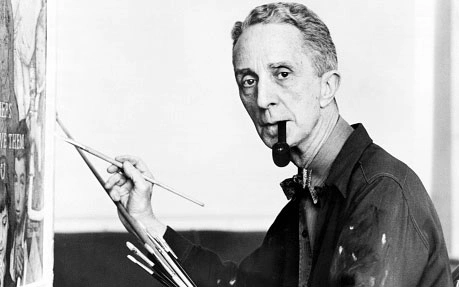
Norman Rockwell is known for his inimitable flamboyant portraiture style that features a sort of exaggerated realism, a sense of wonderful detail, candour, and humour. He infused his art with these traits, for which he used to paint many covers for newspapers and magazines, which focused mainly on traditional and relatively idealized American life in the 20th century, centred around the 1930’s and 1940’s.
More than anything else, Rockwell was a commercial artist. He created eye-catching covers for various magazines for over 4 decades that delighted and amused the American middle-class. His work is now seen as being highly nostalgic, which was seemingly imbued into all his work from the outset. This yearning for a happy-go-lucky vision of wholesome America is likely what brings people back to his work again and again.
In terms of counter culture, or anti-establishment overtones, for which many more subversive artists over the years are known, Rockwell largely avoided this type of commentary in his work. For the majority of his career, he considered himself to be apolitical, and didn’t talk about who he voted for.
Because of the nature of his working relationships with mainstream magazines, he wanted to appeal to “everyone”, as those magazines were made for those particular audiences. Rockwell’s job, for the most part, was to entertain that demographic, with scenes and images that were generally charming to them, with a dash of arguably subtle subversiveness.
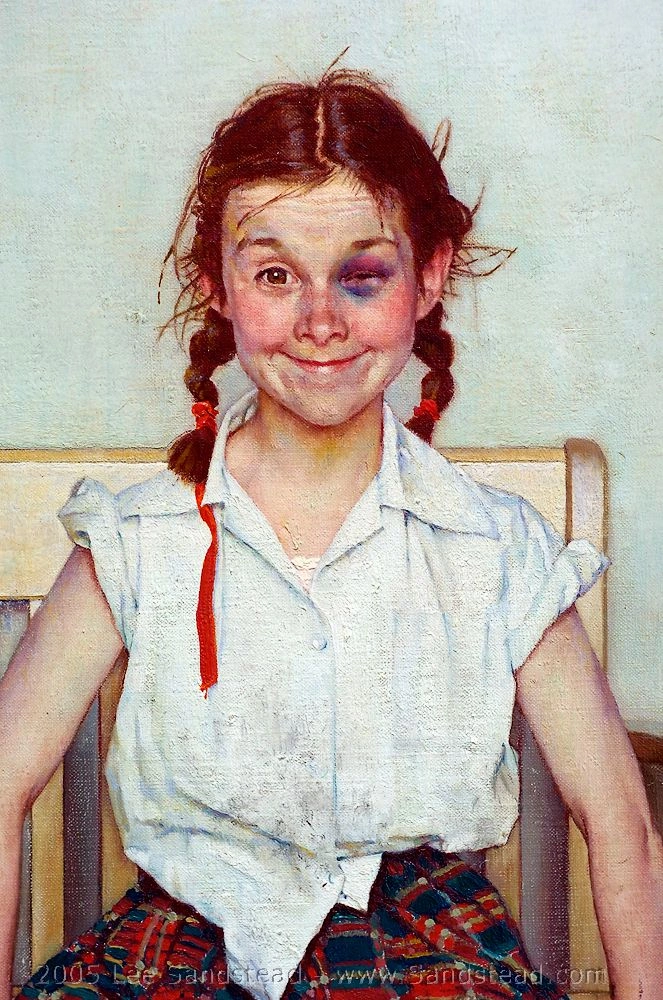
His works often captured specific scenes relatable to American audiences, that frequently depict kids, animals, and various common but zany situations, as well as other chuckle-worthy slices of Americana.
In terms of the “type” of art he made, there was certainly enough detail conveyed in his work for him to be considered a sort of “realist” painter, although one could even call him a caricaturist, as his work was fairly animated and cartoon-ish as well. He was basically the Mel Blanc of painters, where each Rockwell image was like one of Mel’s hilarious voices.
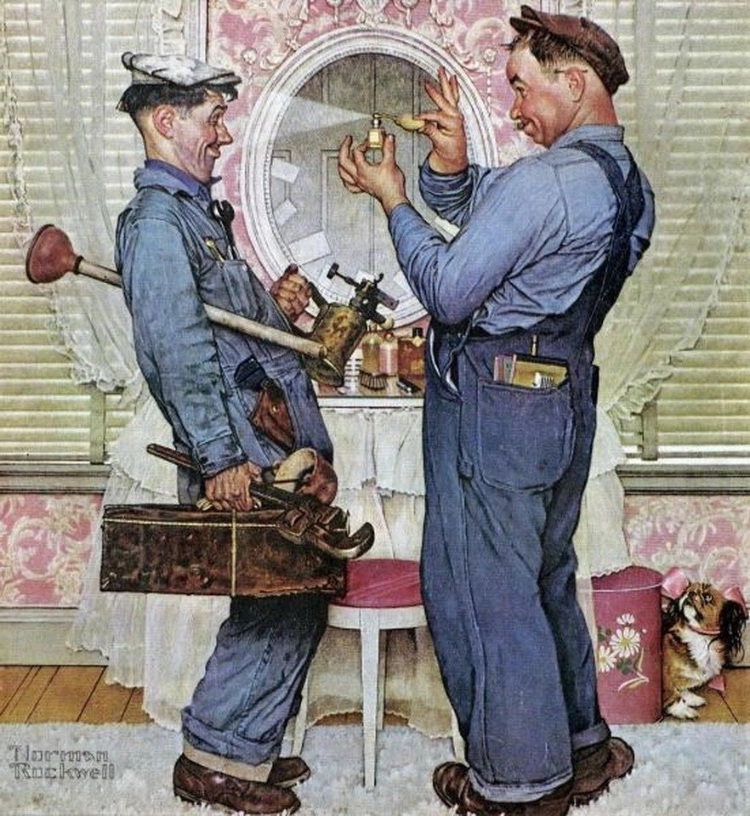
Many, many Rockwell prints have been made over the years. Arguably, next to van Gogh, he is probably one of the most printed artists of all time. Indubitably, depending where in the USA you go, you are bound to encounter a Rockwell print hanging in a restaurant, in someone’s home, office, or just about anywhere. This is a testament to just how popular Norman Rockwell still is, to this day.
Although he was more or less the voice of white middle class America, his works are now – perhaps ironically – extremely, almost obscenely valuable. Rockwell’s original works, these days, go for millions of dollars, and one was even sold for as much as $46 million dollars. That work is called “Saying Grace” (shown below, painted in 1951).

Norman Rockwell was alive to see several significant artistic movements develop through his lifetime, including: Impressionism, Cubism, Surrealism, and Abstract Expressionism. His own painting style seems not be at all similar to these above genres, although Rockwell was certainly aware of them.
In 1961, for example, he painted “The Connoisseur”, which is a nod to Jackson Pollock’s famous abstract style of painting. It’s hard to tell if Rockwell himself is tipping his hat to this style of art, or poking fun. In any event, what it does say to the viewer is that yes, Rockwell was “watching” what was going on around him at the time. This is a sly nod, at the very least.

As huge as Norman Rockwell has become, some people still think of him as almost like a novelty artist, or someone not to be taken seriously.
This is because, for a time, his work was so ubiquitous and sentimental that it appeared on countless postcards, posters, coffee mugs. Rockwell, as an overall artistic presence, is hard to escape…and perhaps some people found this to be bothersome, since his art is more or less the equivalent of being the ham at the party who draws all the attention.
Because, unlike some other artists who were not interested or unable to attain mass acceptance, Rockwell was the definition of popular culture. He’s like the mainstream, more-popular, family-friendly version of Andy Warhol, but decidedly un-avant-garde.

The bottom line, however, is that no matter how you look at Norman Rockwell, he simply oozed talent. The people who enjoyed his work adored what he did, while the people who disliked him for whatever reason usually had to admit that he had some admirable technical abilities, at least.
His work is almost always effective, in terms of what it tries to get across to the viewer. Sometimes Rockwell’s work was (and still is) so entertaining and zany as to be elicit actual laughter from people. His images are like highly realistic, one panel comic strips (although he does have some actual sequential images as well that basically are comic strips).

Rockwell’s work definitely has a comedic edge to it, to a degree where it could almost have been printed in Mad Magazine, just as easily as the Saturday Evening Post, where it frequently appeared for years.
But make no mistake – Norman Rockwell was never was a one-trick-pony – his work always had layers of meaning, even if it was light-hearted. Even the most simple Rockwell piece can be appreciated by a total buffoon, or a snooty intellectual. Both have an equal chance of cracking a smile.
That said, towards the end of his career, even Rockwell finally needed to look at some darker themes in his art, and he became an active voice who reflected on social and racial issues the United States faced in the 20th century. More on that later…
Background
Rockwell was born on February 3rd in New York, US. He started his creative education at the Chase Art School when he was 14 years old and later attended the National Academy of Design and the Art Students League.

Rockwell’s career as an illustrator started from the magazine called Boy’s Life, where he created many cover paintings.
He continued creating the covers for magazines such as the Post, the Literary Digest, the Country Gentleman, Leslie’s Weekly, Life Magazine, and others.
Over time, Norman Rockwell became very comfortable with doing cover illustrations, so his focus became just that. This is why he considers himself more of an illustrator than a painter, per se.
Even though his chosen medium was oils, he still talked in terms of being an illustrator, because his process involved taking a very deliberate photograph (or several), and building up his artwork from there. In other words, his images came from photos, not his mind, like other artists.

Rockwell spent decades doing magazine work based on his method of capturing a moment in a photo and painting it, in order to idealize America. As true to life as a lot of Rockwell’s work certainly was, it ignored a large part of society, and made for a very “white” America, which America was not. Eventually, he could ignore this no longer.
It all changed in the 60’s when Norman couldn’t stand the racial and social inequality and was consequently inspired by Martin Luther King‘s movement.
Themes
Since the beginning of his career, Rockwell focused mostly on topics such as the American people and their daily life, but the truth is that only one race dominated his work and that was, in a nutshell, middle to upper class white folks.
These people were painted in a very realistic way – they had convincing and comical facial expressions and natural body positions. In general, it captured a very true sense of what part of America was like back then around the time of WWII, with the Boyscouts of America, and other wholesome things.
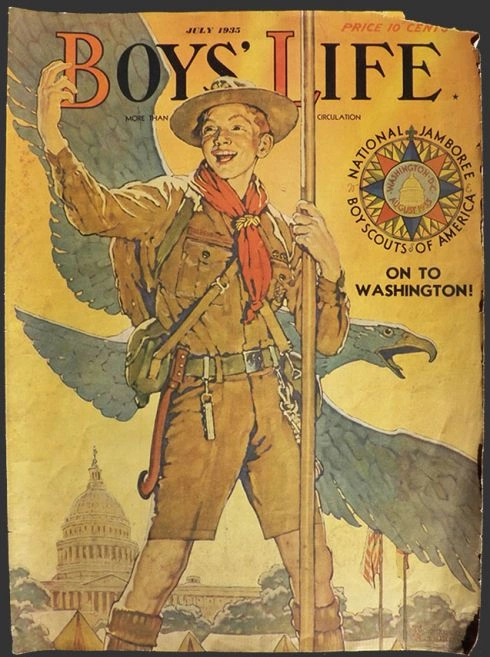
According to the Post’s art editor Kenneth Stuart, the artist knew how to relate with the people he was illustrating because the viewers could have easily experienced the events depicted in his paintings. Rockwell pictured people in a positive, funny, and sweet way.
If, at the beginning of his career, the artist focused more on the traditional American society and positive pictures, then in later years, he started to create more human issues-oriented paintings. These themes slowly but surely crept into his art, making for more poignant depictions of events that were not as silly, and more serious.
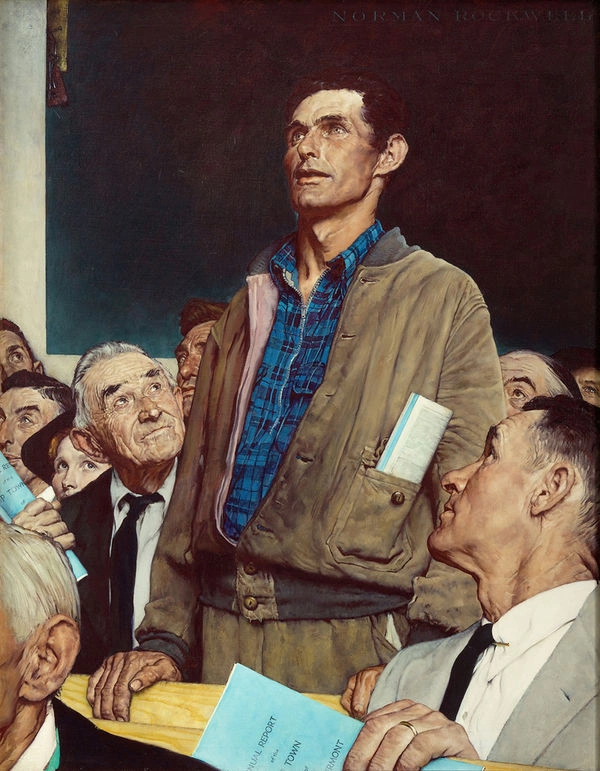
Racism, poverty, gender inequality – these were topics that few fine artists explicitly depicted in their art with as much visual conviction as someone like Rockwell could muster up.
Here now are a few of Rockwell’s works that show his progression from embracing the white middle-class, to portraying an entirely different narrative.
Freedom From Want
Freedom From Want was created in 1943 and posted as an illustration in the Saturday Evening Post.
The illustration of a family sitting at the table and waiting for a huge turkey dinner reflected on a traditional white middle-class American family.

The idea for this work came from President Roosevelt’s declared four freedoms, one of which was called “Freedom From Want”, because people still remembered the Great Depression in the US.
Norman Rockwell painted people he actually knew. For example, there is his wife sitting on the left side of the table and his neighbour sitting on the right. He took pictures of people he knew and then combined them together into one elaborate scene.
Symbolically, white colour takes up a lot of space in the painting, which can be interpreted as a message of positivity, peace, and fullness.
On one hand, this artwork received criticism for being “too idealistic” or “not real fine art”, which is a common complaint through the ages that has been levelled at art by snobbish critics that focuses too much on the “common man”. On the other hand, it has a very clear perspective and has an allusion to the famous Leonardo Da Vinci masterpiece, “The Last Supper”.
These days, in our current age of political correctness, no doubt, it can be seen as being “too white”. But, back in those days, this depiction of life was practically the ideal that people strove for, and so here it was, depicted for them.
Golden Rule
Examining more of his more socially-oriented themes, one of the most popular of Rockwell‘s works is named “Golden Rule”. This was painted 20 years after the previous work, in 1961.
Rockwell used an idea that pictured his philosophy as a man with open and liberal views: “Do unto others as you would have them do unto you”.

Rockwell found this saying quite fascinating, as one that can describe the values of many different religions. He had this idea in this work to create a wide swath of different people, who would represent all kinds of different backgrounds, races, ages, and genders.
Back then, the time he spent on creating this artwork was much longer than he would spend on his typical work, but the result was well worth it – this wasn’t an ordinary painting, but something that was starting to become “realistic” in a way none of his previous works actually were, which is to say, he was finally starting to depict America for what it was, which was a multi-racial country.
This artwork has a very special and powerful message to the viewers. Any person who is looking at it can see multiple groups of people, but at the same time find someone to whom he or she can relate. Rockwell’s idea was to reflect not on one or a few social groups, but on all kinds of people to show how we are all equal.
The Problem We All Live With
One of the most influential works made by Norman Rockwell on the topic of racism is called “The Problem We All Live With”.
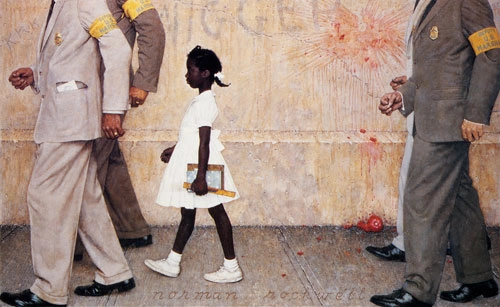
The title is unusual, but it hints towards social issues before the viewer even sees it. The painting shows four men walking with a black young girl with tomatoes hit a wall in the background and the N-word written on that wall.
The angle of this painting is focused on a girl and it gives an impression that this girl is of course no danger at all, despite what skin colour she has.
Like most of Rockwell’s paintings, this one is also inspired by true events. It pictures a scene based on a real event when six-year-old girl Ruby Bridges was led to William Frantz Elementary School for the first time on 14th November 1960.

Due to security issues because of her race, she was provided with deputy U. S. marshals. This artwork was made in the light of the New Orleans school desegregation crisis and symbolizes the Civil Rights Movement in the United States.
This painting was hung in the hallway outside the Oval Office at the White House during President’s Barack Obama presidency.
Rockwell made yet another racial statement with a work called “Racial Justice”, in 1965, based on events that took place in Mississippi.

Conclusion
Norman Rockwell, as it stands, is an artist who is often mischaracterized. As one of the most famous artists in history, perhaps it is inevitable that he might be misunderstood, as many visionary artists are.
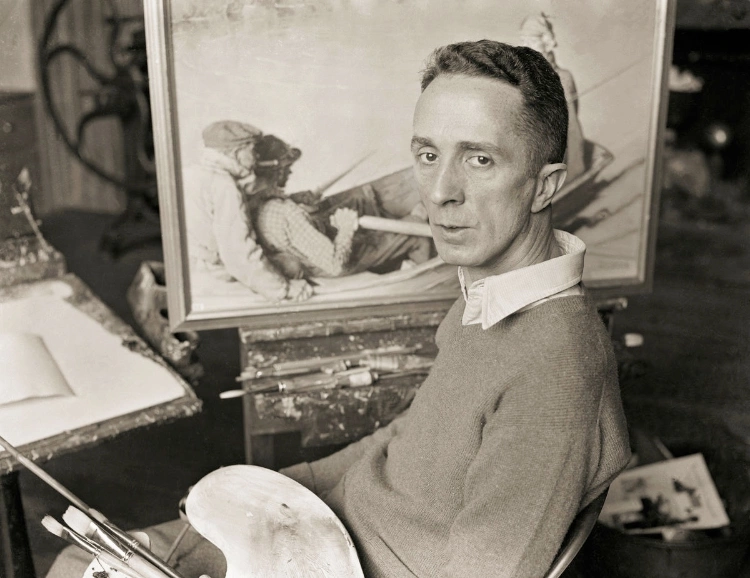
To recap briefly, he is a painter, but considered himself an illustrator, due, probably, to working in that capacity for decades for the Saturday Evening Post.
Rockwell is one of the most popular painters of all time, but at the same time, a lot of critics don’t take his work seriously, because it was “lowbrow” in some way, and funny at the same time. In this regard, he is looked at by certain scholars as next to a cartoonist, and cartoonists are often not given the same appreciation as fine artists.
In any case, Norman Rockwell, as has been stated earlier, is a hard person to escape. His work permeates American culture, then as now, and has many fans around the world, and for good reason(s). Comment below if you have something to add.
More Rockwell (Videos)

About David Fox
David Fox is an artist who created davidcharlesfox.com to talk about art and creativity. He loves to write, paint, and take pictures. David is also a big fan of spending time with his family and friends.
Leave a Reply
 |
 |
 |
 |
Just Art and Fun
Now get FREE Gifts. Or latest Free phones here.
Disable Ad block to reveal all the secrets. Once done, hit a button below
 |
 |
 |
 |